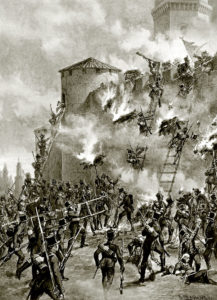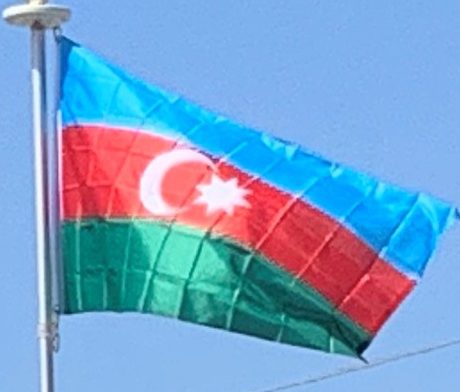Following Qajar Iran’s loss in the 1804–1813 war, it was forced to concede suzerainty over most of the khanates, along with Georgia and Dagestan to the Russian Empire, per the Treaty of Gulistan.
The area to the north of the river Aras, amongst which territory lies the contemporary Republic of Azerbaijan, was Iranian territory until it was occupied by Russia in the 19th century. About a decade later, in violation of the Gulistan treaty, the Russians invaded Iran’s Erivan Khanate. This sparked the final bout of hostilities between the two, the Russo-Persian War of 1826–1828. The resulting Treaty of Turkmenchay, forced Qajar Iran to cede sovereignty over the Erivan Khanate, the Nakhchivan Khanate and the remainder of the Lankaran Khanate, comprising the last parts of the soil of the contemporary Azerbaijani Republic that were still in Iranian hands. After incorporation of all Caucasian territories from Iran into Russia, the new border between the two was set at the Aras River, which, upon the Soviet Union’s disintegration, subsequently became part of the border between Iran and the Azerbaijan Republic.

After the collapse of the Russian Empire during World War I, the short-lived Transcaucasian Democratic Federative Republic was declared, constituting the present-day republics of Azerbaijan, Georgia, and Armenia.
It was followed by the March Days massacres that took place between 30 March and 2 April 1918 in the city of Baku and adjacent areas of the Baku Governorate of the Russian Empire. When the republic dissolved in May 1918, the leading Musavat party declared independence as the Azerbaijan Democratic Republic (ADR), adopting the name of “Azerbaijan” for the new republic; a name that prior to the proclamation of the ADR was solely used to refer to the adjacent northwestern region of contemporary Iran. The ADR was the first modern parliamentary republic in the Muslim world. Among the important accomplishments of the Parliament was the extension of suffrage to women, making Azerbaijan the first Muslim nation to grant women equal political rights with men. Another important accomplishment of ADR was the establishment of Baku State University, which was the first modern-type university founded in the Muslim East.
By March 1920, it was obvious that Soviet Russia would attack Baku. Vladimir Lenin said that the invasion was justified as Soviet Russia could not survive without Baku’s oil. Independent Azerbaijan lasted only 23 months until the Bolshevik 11th Soviet Red Army invaded it, establishing the Azerbaijan SSR on 28 April 1920. Although the bulk of the newly formed Azerbaijani army was engaged in putting down an Armenian revolt that had just broken out in Karabakh, Azerbaijanis did not surrender their brief independence of 1918–20 quickly or easily. As many as 20,000 Azerbaijani soldiers died resisting what was effectively a Russian reconquest.

On 13 October 1921, the Soviet republics of Russia, Armenia, Azerbaijan, and Georgia signed an agreement with Turkey known as the Treaty of Kars. The previously independent Republic of Aras would also become the Nakhichevan Autonomous Soviet Socialist Republic within the Azerbaijan SSR by the treaty of Kars. On the other hand, Armenia was awarded the region of Zangezur and Turkey agreed to return Gyumri (then known as Alexandropol).
